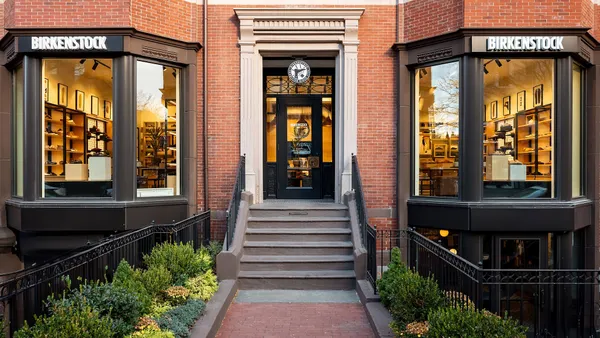UPDATE: June 18, 2020: J.C. Penney announced that closing sales at 136 stores began Wednesday, run by liquidation firms Gordon Brothers, Hilco Merchant Resources, Great American Group and Tiger Capital Group. Locations in 37 states are clearing merchandise with storewide discounts of 25% to 40%, according to a company press release. "A handful of previously announced store closing locations remain on hold pending further review," according to a company blog post.
The stores are open Monday through Saturday, noon to 7 p.m. and Sunday 11 a.m. to 6 p.m., with designated hours on Wednesdays and Fridays, 11 a.m. to noon, reserved for at-risk shoppers, including senior citizens, pregnant women and people with health issues that make them especially vulnerable to COVID-19.
Dive Brief:
- J.C. Penney has identified 154 stores it plans to permanently close initially in bankruptcy, with more closures expected to come as the department store chain winds through the court process.
- Going-out-of-business sales will start upon court approval of Penney's plan, the company said in a press release. A hearing on the matter is scheduled for June 11.
- On Thursday, Penney received court approval for a bankruptcy financing package that gives it immediate access to $225 million, with access to an equal amount in July, subject to conditions. Approval came over objections from some creditors who took issue with the terms and securitization of the financing package.
Dive Insight:
J.C. Penney is making progress on its efforts to reorganize and execute a long-promised turnaround. But its ultimate fate in bankruptcy, and beyond, is far from certain.
While routine in retail bankruptcies, winning new financing, known as debtor-in-possession (DIP), was a crucial first step to its initial turnaround efforts. In a statement, CEO Jill Soltau said of the DIP approval, "This is a positive step forward that will help us execute our Plan for Renewal and store optimization strategy, continue working seamlessly with our vendor partners, fund our ongoing business operations, and continue our focus on further developing the Company's go-forward business plan to successfully restructure JCPenney."
But what's good for J.C. Penney's DIP lenders isn't necessarily good for other stakeholders, or Penney. In a filed objection, the committee of Penney's unsecured creditors ripped into the DIP terms. They called the second tranche of the credit facility, which Penney can't access until July, as "entirely optional" for the lenders.
"After providing an initial $225 million, the DIP Lenders may simply refuse to loan any additional amounts on July 15th if a majority of the Consenting First Lien Lenders and 66.7% of the DIP Lenders do not approve a go-forward Business Plan," attorneys for the group said in the objection.
Approval of Penney's business plan is a key milestone in the case. Without lender support, Penney could go into liquidation despite all of the retailer and its executives' talk of a turnaround plan and a bright future for the company. A liquidation of J.C. Penney, the unsecured group notes, could come within just six weeks.
Moreover, they noted that the DIP comes with hefty fees attached, including $45 million paid before the retailer's bankruptcy filing and $27 million more in exit fees due later, as well as an interest rate nearly double that of Penney's pre-bankruptcy credit facility, which is getting rolled up into the DIP.
Along with the fees, the DIP is secured by new collateral (i.e., that wasn't backing its pre-Chapter 11 facility), which makes that collateral and its value unavailable to other creditors, the unsecured group argued. A representative for Penney said in a hearing Thursday that the retailer tried to negotiate on many of the key points of its final DIP agreement with lenders, but was unable to get financing on better terms.
A pared down footprint and new capital at least gives Penney a chance to orchestrate a turnaround and reorganization that will survive its current bankruptcy. Analysts by and large have said Soltau and her team have made the right moves to get the retailer's inventory and merchandising in proper order.
But the retailer plays in a declining department sector made all the more uncertain by the coronavirus pandemic and ensuing economic crisis. Those factors, and the decisions of J.C. Penney's DIP lenders, could determine its ultimate fate.













